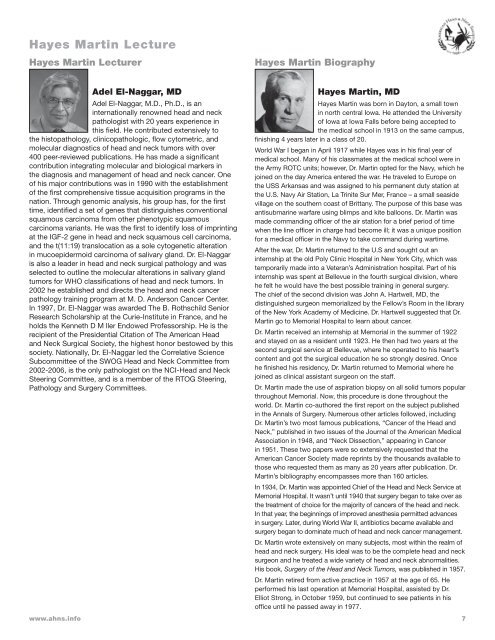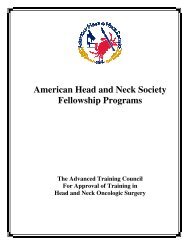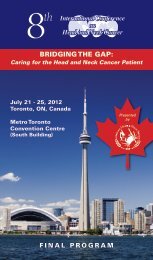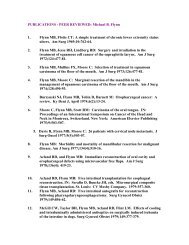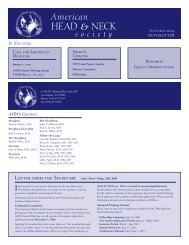Download - American Head and Neck Society
Download - American Head and Neck Society
Download - American Head and Neck Society
You also want an ePaper? Increase the reach of your titles
YUMPU automatically turns print PDFs into web optimized ePapers that Google loves.
Hayes Martin Lecture<br />
Hayes Martin Lecturer<br />
Hayes Martin Biography<br />
www.ahns.info<br />
Adel El-Naggar, MD<br />
Adel El-Naggar, M.D., Ph.D., is an<br />
internationally renowned head <strong>and</strong> neck<br />
pathologist with 20 years experience in<br />
this field. He contributed extensively to<br />
the histopathology, clinicopathologic, flow cytometric, <strong>and</strong><br />
molecular diagnostics of head <strong>and</strong> neck tumors with over<br />
400 peer-reviewed publications. He has made a significant<br />
contribution integrating molecular <strong>and</strong> biological markers in<br />
the diagnosis <strong>and</strong> management of head <strong>and</strong> neck cancer. One<br />
of his major contributions was in 1990 with the establishment<br />
of the first comprehensive tissue acquisition programs in the<br />
nation. Through genomic analysis, his group has, for the first<br />
time, identified a set of genes that distinguishes conventional<br />
squamous carcinoma from other phenotypic squamous<br />
carcinoma variants. He was the first to identify loss of imprinting<br />
at the IGF-2 gene in head <strong>and</strong> neck squamous cell carcinoma,<br />
<strong>and</strong> the t(11:19) translocation as a sole cytogenetic alteration<br />
in mucoepidermoid carcinoma of salivary gl<strong>and</strong>. Dr. El-Naggar<br />
is also a leader in head <strong>and</strong> neck surgical pathology <strong>and</strong> was<br />
selected to outline the molecular alterations in salivary gl<strong>and</strong><br />
tumors for WHO classifications of head <strong>and</strong> neck tumors. In<br />
2002 he established <strong>and</strong> directs the head <strong>and</strong> neck cancer<br />
pathology training program at M. D. Anderson Cancer Center.<br />
In 1997, Dr. El-Naggar was awarded The B. Rothschild Senior<br />
Research Scholarship at the Curie-Institute in France, <strong>and</strong> he<br />
holds the Kenneth D Műller Endowed Professorship. He is the<br />
recipient of the Presidential Citation of The <strong>American</strong> <strong>Head</strong><br />
<strong>and</strong> <strong>Neck</strong> Surgical <strong>Society</strong>, the highest honor bestowed by this<br />
society. Nationally, Dr. El-Naggar led the Correlative Science<br />
Subcommittee of the SWOG <strong>Head</strong> <strong>and</strong> <strong>Neck</strong> Committee from<br />
2002-2006, is the only pathologist on the NCI-<strong>Head</strong> <strong>and</strong> <strong>Neck</strong><br />
Steering Committee, <strong>and</strong> is a member of the RTOG Steering,<br />
Pathology <strong>and</strong> Surgery Committees.<br />
Hayes Martin, MD<br />
Hayes Martin was born in Dayton, a small town<br />
in north central Iowa. He attended the University<br />
of Iowa at Iowa Falls before being accepted to<br />
the medical school in 1913 on the same campus,<br />
finishing 4 years later in a class of 20.<br />
World War I began in April 1917 while Hayes was in his final year of<br />
medical school. Many of his classmates at the medical school were in<br />
the Army ROTC units; however, Dr. Martin opted for the Navy, which he<br />
joined on the day America entered the war. He traveled to Europe on<br />
the USS Arkansas <strong>and</strong> was assigned to his permanent duty station at<br />
the U.S. Navy Air Station, La Trinite Sur Mer, France – a small seaside<br />
village on the southern coast of Brittany. The purpose of this base was<br />
antisubmarine warfare using blimps <strong>and</strong> kite balloons. Dr. Martin was<br />
made comm<strong>and</strong>ing officer of the air station for a brief period of time<br />
when the line officer in charge had become ill; it was a unique position<br />
for a medical officer in the Navy to take comm<strong>and</strong> during wartime.<br />
After the war, Dr. Martin returned to the U.S <strong>and</strong> sought out an<br />
internship at the old Poly Clinic Hospital in New York City, which was<br />
temporarily made into a Veteran’s Administration hospital. Part of his<br />
internship was spent at Bellevue in the fourth surgical division, where<br />
he felt he would have the best possible training in general surgery.<br />
The chief of the second division was John A. Hartwell, MD, the<br />
distinguished surgeon memorialized by the Fellow’s Room in the library<br />
of the New York Academy of Medicine. Dr. Hartwell suggested that Dr.<br />
Martin go to Memorial Hospital to learn about cancer.<br />
Dr. Martin received an internship at Memorial in the summer of 1922<br />
<strong>and</strong> stayed on as a resident until 1923. He then had two years at the<br />
second surgical service at Bellevue, where he operated to his heart’s<br />
content <strong>and</strong> got the surgical education he so strongly desired. Once<br />
he finished his residency, Dr. Martin returned to Memorial where he<br />
joined as clinical assistant surgeon on the staff.<br />
Dr. Martin made the use of aspiration biopsy on all solid tumors popular<br />
throughout Memorial. Now, this procedure is done throughout the<br />
world. Dr. Martin co-authored the first report on the subject published<br />
in the Annals of Surgery. Numerous other articles followed, including<br />
Dr. Martin’s two most famous publications, “Cancer of the <strong>Head</strong> <strong>and</strong><br />
<strong>Neck</strong>,” published in two issues of the Journal of the <strong>American</strong> Medical<br />
Association in 1948, <strong>and</strong> “<strong>Neck</strong> Dissection,” appearing in Cancer<br />
in 1951. These two papers were so extensively requested that the<br />
<strong>American</strong> Cancer <strong>Society</strong> made reprints by the thous<strong>and</strong>s available to<br />
those who requested them as many as 20 years after publication. Dr.<br />
Martin’s bibliography encompasses more than 160 articles.<br />
In 1934, Dr. Martin was appointed Chief of the <strong>Head</strong> <strong>and</strong> <strong>Neck</strong> Service at<br />
Memorial Hospital. It wasn’t until 1940 that surgery began to take over as<br />
the treatment of choice for the majority of cancers of the head <strong>and</strong> neck.<br />
In that year, the beginnings of improved anesthesia permitted advances<br />
in surgery. Later, during World War II, antibiotics became available <strong>and</strong><br />
surgery began to dominate much of head <strong>and</strong> neck cancer management.<br />
Dr. Martin wrote extensively on many subjects, most within the realm of<br />
head <strong>and</strong> neck surgery. His ideal was to be the complete head <strong>and</strong> neck<br />
surgeon <strong>and</strong> he treated a wide variety of head <strong>and</strong> neck abnormalities.<br />
His book, Surgery of the <strong>Head</strong> <strong>and</strong> <strong>Neck</strong> Tumors, was published in 1957.<br />
Dr. Martin retired from active practice in 1957 at the age of 65. He<br />
performed his last operation at Memorial Hospital, assisted by Dr.<br />
Elliot Strong, in October 1959, but continued to see patients in his<br />
office until he passed away in 1977.<br />
7


